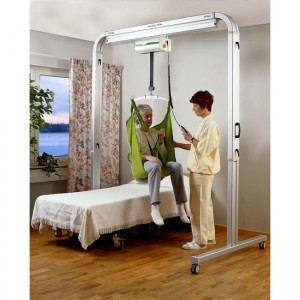A patient lift is an assistive device that allows patients in hospitals, nursing homes, or those receiving home health care, who cannot lift themselves, or are otherwise mobility challenged, to be transferred between a bed, a chair, a wheelchair, or a commode. Patient lifts help ensure the safety of both the patient and his or her caregiver.
There are several different types of patient lifts available, including sit-to-stand lifts, which are often on the floor, and sling lifts which can either be floor-based or attached to a ceiling or an overhead track.
The sit-to-stand lift is designed to help patients who have some mobility, but lack the strength to rise to a standing position from a bed, wheelchair, chair, or commode, yet do have the strength both to sit up and to physically support their weight while standing. They are designed to transfer a patient between two seating surfaces. They employ straps, vests, or belts that usually fit under a patient’s arms and utilize hydraulic power to operate, much like a floor-based automobile jack. Sit-to-stand lifts fix a patient’s legs in position while the lift mechanism gradually moves his or her body into a standing position, and then reverses the process when the patient needs to be seated.
The sling lift, sometimes known as a Hoyer Lift, is used to lift a patient entirely off a bed, chair, wheelchair, or commode. It is used for patients who have either no mobility at all or enough strength to support themselves while standing. The use of a sling lift involves placing a piece of fabric that is attached to a series of hooks or clips, under the patient. The sling must be strong enough to hold the weight of the patient while he or she is suspended in air. Patients who cannot withstand being bent or compressed can be lifted via stretcher sling lifts which are used for supine transfer.
Sling lifts that are permanently installed on the ceiling of a room are called ceiling lifts. Ceiling lifts use the same sling technology as floor sling lifts, with the additional possibility of having a track system attached to the ceiling for the horizontal movement of a patient within his or her room, or into an adjoining room or bathroom. They also free up the floor space that is necessary for a floor lift. Ceiling lifts generally utilize an electric motor to operate their lift mechanism. Sling lifts also come in modular, free-standing styles with overhead track systems similar to those of ceiling lifts. They are less expensive than installed ceiling lifts, and can be moved from room to room as required.
The pressure fit lift is a type of sling lift that provides the function of a typical ceiling lift, without the need for a permanent installation. The overhead track, to which the sling is attached, is mounted between two poles that extend from the floor to the ceiling. This type of lift is ideal for rental situations or wherever a ceiling lift or permanent track installation is not possible or too difficult to mount, safely.
https://www.youtube.com/watch?v=wkKADjwPUKA
President, Husband, Father, Grandfather Graduate of UC Davis- Bio Sci Major- Go Aggies! Jeff has extensive experience in all of Pacific Mobility’s products and services, and specializes in accessibility products as well as stairlifts, ceiling lifts and custom wheel chairs. His hobbies include spending time with family, gardening, mountain biking, exercising and off road motorcycle riding.
24 years as Owner/President of Pacific Mobility Center – selling, installing, and servicing stairlifts, porch lifts, ceiling lifts, pool lifts, handicap ramping, specialty wheelchairs, scooters, power wheel chairs, and other power mobility devices
Certified Environmental Access Consultant since 2008
Licensed General Contractor since 1998
Certified Aging in Place Specialist since 2016
Board Member for Home Access Professionals
Member of Association of Members of the Accessibility Equipment Industry (AEMA)




